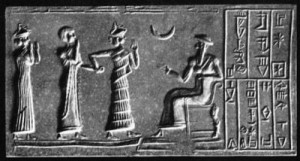Are Past Lives Real? My Friend’s True Story
A close friend of mine had this happen to her. This is a 100% true story. I’m a little jealous it didn’t happen to me, because it’s a really freakin’ cool story. (But not that jealous, because, as you’ll see, it’s not all sunshine and roses.)
Because this friend is in a conservative profession in a conservative part of the country, she’d rather be anonymous for this post, therefore, we will call her “Jan.” It should also be noted that ever since I’ve known Jan (which is many years), she is almost infamous for how often she has to use the lady’s room (number 1, thank you). It is constant. This is pertinent to the story, so bear with me.
 |
| Source |
A few years ago, Jan was dating a fellow for a short spell. It was not the smoothest of relationships, and when they finally broke up, Jan was particularly torn up about it — “unnaturally” so, as she put it. Sure, he had become cold as ice, but Jan had handled break-ups before, so why was this one so devastating?
The therapist she saw on occasion suggested that perhaps she try a past-life regression. Jan was open to the idea — anything to give insight into this painful split.
(For those of you new the concept of past lives, please know that many people believe that our souls reincarnate over and over again on the Earth plane, in different bodies and throughout time, to work out “karma.” I personally find this notion fascinating. After all, a glimpse into a past life can offer tremendous information about the current one and can be used as a powerful healing modality.
Jan’s story is one such example.)
The therapist led Jan through a sort of hypnosis, where Jan was to imagine herself back to a time when she felt 100% happy and secure. She saw herself nursing at her mother’s breast. After that, the therapist guided her to go back further, to a time and place before she was born in this body.
“Go back to the first time that you really felt abandoned,” the therapist suggested. “Now look at your feet.”
 |
| source |
Jan’s mind’s-eye looked down and saw lovely tiny dark feet wearing exquisitely beautiful sandals. As the therapist kept making suggestions and asking questions, guiding the regression, Jan saw herself as a dainty and pretty young woman from a noble family in Egypt. She saw her parents, who were nurturing and kind. There was singing and dancing, and it was obvious that she lived a charmed and extremely happy childhood. Soon enough, at marrying age, she became one of the King’s wives, given that she was beautiful and of noble birth.
Here’s where the story gets ugly. The next thing Jan felt, as her therapist led her along, was absolute devastation. She was suddenly starkly alone. It turned out that this girl-queen had given birth to a baby boy, and the baby had died from intense childbirth complications. As a result, the childless mother had been confined to a dark, small, dungeon-type room.
It was there that this young queen died, completely abandoned, completely distraught.
Jan intuitively understood that the current ex-boyfriend was indeed the king who had left her to this cruel death, which is why it was so difficult for Jan to process the break-up. Jan was recalling that past life on a subconscious level, in order to heal it.
Sure enough, after this regression, Jan felt much calmer about the whole break-up and was able to move on. In her words, “Something had shifted.”
 |
| Source |
The story would typically end here, and you, dear reader, would perhaps leave this post, casually considering whether there is any validity to this past life thing, or if it’s simply a trick of the mind to help process intense emotions. After all, how glamorous (and cliche) to have been a beautiful Egyptian queen, right?
However, the next week, Jan ran into an acquaintance, “Lisa,” whom she hadn’t seen in a long while. They agreed to meet up for lunch to reconnect. At that lunch, Jan felt moved to tell Lisa about the past life regression. To Jan’s surprise, Lisa said, “I know what you had.”
Jan said, “Excuse me?”
“I know what you had, after childbirth, that made you go into confinement,” Lisa continued. “You know, every year I pick a new charity to support, and this year, I picked one on this medical condition called ‘fistula.'” Lisa went on to explain that obstetric fistula is a condition that can happen to mothers in or leading to difficult childbirths. Often the baby dies, and the mother is left without the ability to control her urine or feces.
Back in ancient Egypt, before modern medicine, it is absolutely possible that even a queen would be put into confinement and left to die, given that she had no way to control her bodily excrements and would be considered unclean and unfit to be in public or even remain alive.
Jan could feel a chord of truth in Lisa’s suggestion, uncanny as it was.
That evening, Jan dared to type these words into the Google search engine:
fistula egyptian queen
Sure enough, she found the following:
Vesicovaginal fistula was first documented in the mummified remains of Egyptian Queen Henhenit (11th Dynasty, 2050 BC), which were examined in 1923 by Derry.1
And then more:
The modern study of ancient Egypt began with Napoléon’s invasion in 1798. Napoléon took with him a small army of scholars and scientists to investigate Egyptian civilization, resulting in the discovery of the Rosetta Stone and a new fascination with mummies. The mummy of Queen Henhenit shows evidence of horrific childbirth trauma, providing early evidence of the dangers and difficulty of human childbirth. Against this background, Dr. L. Lewis Wall, M.D., Ph.D., M.A., of Washington University, describes the problem of obstructed labor in developing countries, explains the nature of the severe childbirth injuries encountered there, and discusses his work with birth-injured women in Africa and his project to build a specialty hospital in the West African country of Niger.
And then more:
“In 1935 Professor D.E. Derry at the Cairo School of Medicine examined the mummified remains of an Egyptian Queen, Queen Henhenit, who had lived around 2050 BC. When the abdominal cavity was opened Derry discovered an opening between the bladder and vagina. Queen Henhenit’s pelvis was an abnormal shape and Derry postulated that it would have been difficult for a fetal head to pass. The severe damage he found probably occurred at the time of childbirth, resulting in Henhenit’s death. The hole in the bladder, he thought, may have been caused by the abnormally narrow pelvis through which the child had to be dragged by force. Poor Queen Henhenit had the dubious honor or having had the earliest known vesico-vaginal fistula.” –from The Hospital by the River: A Story of Hope by Catherine Hamlin
After these amazing finds, I’m happy to report that Jan does not feel the pressing need to urinate every thirty minutes, but instead only every hour or so. I’m also happy to report that she has given birth to healthy children in this lifetime, with no complications nor drama. I would also like to stress that Jan is not in the medical field and had never heard of fistula before that day, nor had she studied ancient Egypt in any way where she would have come across this sliver of information, making it impossible for her psyche to be impressed with this story.
So I ask you, dear reader, what do you think? Do we only live once? Or do we get to come back over and over and over, real time travelers and explorers of the Earth and life?
In other words: Who….are…you?
 |
| Alice in Wonderland (source) |
 |
| Source |


